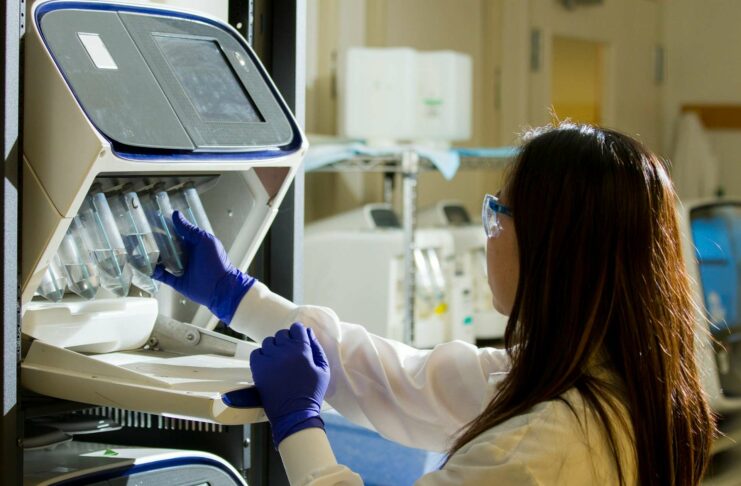In the bustling world of medical diagnostics, two key players emerge on the stage: In Vitro Diagnostic (IVD) tests and Institution-developed Tests (IHDs), each playing a pivotal role in advancing patient care within health institutions. With the European Union’s stringent regulations under the spotlight, the landscape of patient testing is undergoing a significant transformation, particularly with the enforcement of the In Vitro Diagnostic Medical Devices Regulation (IVDR) since 26 May 2022.
Under this new regulatory regime, IVD tests — the tools that healthcare professionals rely on for diagnosing diseases and conditions — have entered a new era of scrutiny. Starting from May 2028, before these products can grace the EU market, they undergo a rigorous vetting process, requiring a nod of approval from an independent entity known as a notified body (NB). Achieving this milestone allows manufacturers to adorn their IVD products with the Conformité Européenne (CE) mark, a seal of approval that opens doors across the EU marketplace.
IHDs – tailored by health institutions for expanding services, personalized medicine, or specialist support – however, are restricted under IVDR to use within their originating institutions, barred from external legal entity trans.
Taking things in-house with IHDs
Despite falling into a regulatory grey area under the IVDR, IHDs stand as bespoke diagnostic solutions crafted, executed, and utilized within the confines of individual healthcare facilities. Characterized by their in-house development and application for patient screening or diagnostic evaluation, IHDs occupy a unique niche, maintaining their status as long as they remain within the originating institution’s walls, unshared or undistributed, in line with a set of extensive provisions listed in IVDR Article 5(5).
Oversight for these tailored diagnostic instruments falls to the Competent Authority (CA) – legally designated individuals or organizations authorized to perform specific regulatory functions. within the developer’s jurisdiction. Meanwhile, IVD tests, when commercialized and distributed to labs, healthcare networks, or directly to consumers, assume the formal classification of medical devices, distinguishing them from their institutionally anchored counterparts.
For decades, a mosaic of independent, university-affiliated, hospital-associated, and reference laboratories has been quietly shaping the landscape of diagnostics through the development of IHDs. The impetus behind IHDs often springs from necessity; the markets for certain assays, particularly those targeting rare diseases, can be so minute that commercial ventures deem them economically unviable. This gap leaves a swath of unmet clinical needs, especially in specialized research and patient care areas focused on less common conditions.
Health institutions often take the initiative to develop IHDs, especially when there is a gap in standardized assays for monitoring disease progression or evaluating treatment responses. A prime example is the development of an IHD for complex multigenic diseases like cancer, where an institution might create its genetic polymorphism panel. This custom panel helps in classifying the disease and determining the suitability of specific therapies. Furthermore, IHDs play a critical role in identifying novel biomarkers for distinct diseases.
IHDs stand at the forefront of diagnostic innovation, targeting an expansive array of biological markers from small molecules and proteins to ribonucleic acid (RNA), deoxyribose nucleic acid (DNA), cells, and pathogens. The technological spectrum of IHDs spans from cutting-edge molecular diagnostics and immunoassays to sophisticated mass spectrometry.
Whether it is a straightforward assay pinpointing a specific biomarker or a complex test deploying intricate algorithms to evaluate a multitude of analytes and biomarkers, IHDs and IVDs alike are pivotal in advancing our understanding and management of diseases. This versatility not only underscores the adaptability of diagnostic tools in meeting diverse healthcare needs but also highlights the relentless pursuit of precision and accuracy in patient care.
In the European Union, the landscape for IHDs is nuanced yet accommodating, with the In Vitro Diagnostic Regulation (IVDR) allowing their use, especially when no CE-IVDs exist for certain diseases. Despite a general exemption from full IVDR compliance for health institutions crafting IHDs, they are not entirely unbridled; they must adhere to certain regulatory stipulations, such as those in Article 5(5) still cast a long shadow over their operations. Yet, the regulatory tide is turning. From May 2028, the marketing of an IHD in the presence of an equivalent CE-IVD will demand proof of its unique value to patient populations, tightening the leash on innovation in a market driven by necessity.
The advantages of steering the course toward IHD development are manifold. Laboratories hold the reins tightly, dictating the content, targets, and applications of their tests. This control extends to the rapid adaptation of tests to meet evolving market needs, consolidating multiple analytes into a single diagnostic procedure for more efficient and faster diagnosis. Despite the looming IVDR, laboratories enjoy a period of grace; certain Quality Management System (QMS) requirements loom on the horizon but are not yet in force, and standards like ISO 15189, though pivotal, are not uniformly mandated across EU member states.
Faced with the challenges of unavailable CE-IVDs for specific conditions, the inability to scale up IVDs for necessary throughput, and the relentless quest for competitive advantage, these laboratories are turning to IHDs as a beacon of innovation. IHDs not only promise an improvement over existing assays but also offer the agility to rapidly develop tests tailored to precise procedures and utilities, bypassing the lengthy timelines and performance limitations associated with traditional IVD tests. This strategic pivot is not just about fulfilling a technical necessity; it is about redefining excellence in patient care, ensuring that laboratories remain at the forefront of medical innovation, and securing their competitive edge in the fast-evolving landscape of healthcare diagnostics.
Navigating the regulatory landscape for diagnostic excellence with IVDs
Similar to IHDs, IVDs are molecular diagnostics kits that delve deep into the essence of human health, scrutinizing samples to unearth crucial data—from the levels of mundane molecules like sodium and cholesterol to the critical markers indicating genetic anomalies or immune battles against infections. For healthcare practitioners, IVD tests are not just tools but trusted allies, guiding diagnoses, informing treatment pathways, and acting as sentinels against the specter of future diseases. Imagine, if you will, a screening test that can whisper predictions about a patient’s health odyssey, arming them and their doctors with the foresight to navigate the challenges ahead.
Across the European Union’s meticulously regulated healthcare market, the journey from laboratory to patient bedside for medical devices, including IVD tests, is a gauntlet lined with regulatory hurdles. Devices are knighted into classes—A (sterile), B, C, or D—based on a calculus of risk, with Class A non-sterile devices enjoying the privilege of a self-declared entry into the market. The gatekeepers in this realm are the Notified Bodies (NBs), entities charged with the solemn duty of assessing products for their compliance with the realm’s laws. Meanwhile, the CAs oversee the broader domain, ensuring that NBs perform their assessments with diligence. Under the vigilant gaze of the IVDR, IVD tests designed for commercial deployment must prove their worthiness, ensuring their safety and performance are beyond reproach.
Yet, the narrative of IVD tests is not just one of regulatory conquests. It is a tale of strategic advantage. The strategic adoption of IHD tests equips laboratories with significant advantages, tailored for precision and efficiency. A robust quality system ensures each test meets stringent requirements from design to complaint monitoring, streamlining the process with simplified inventory control that cuts back on documentation and maintenance. Immediate access to technical support guarantees the swift resolution of issues, minimizing operational disruptions.
Moreover, the clinical validity of these tests is rigorously established, ensuring accurate detection and measurement of specific analytes, vital for diagnosing clinical conditions. The broad distribution of IHDs enables a collective affirmation of test accuracy, as data from diverse laboratories converge to solidify the test’s reliability, enhancing confidence in its global utility.
The decision to invest in an IVD is underpinned by a strategic confluence of quality, compliance, and market presence. The choice is clear when considering the broader distribution of testing and the potential uptick in revenue, positioning the IVD as a lucrative asset in the competitive landscape. These devices are meticulously engineered with robust design controls, ensuring that each product meets the industry’s gold standard—easier to achieve with the regulatory expertise of a notified body.
The manufacturing controls stand as a means of consistency, and with a focus on complete clinical validity, IVDs undergo thorough clinical validation before market entry, instilling confidence in their diagnostic precision. When it comes to post-market vigilance, adverse event reporting mechanisms are integral, providing real-time data that helps refine and elevate product safety. This holistic approach to design, validation, and quality control doesn’t just make a case for purchasing an IVD from reputable molecular diagnostic kit suppliers—it cements its status as an indispensable tool in the arsenal of healthcare innovation.
The contrast between CE-IVDs and IHDs could not be more pronounced. While CE-IVDs, aimed at a wide audience from diagnostic labs to consumers, undergo a gauntlet of pre-validation and standardized training, IHDs tread a more personalized path. These in-house developed assays, spurred by the absence of suitable commercial options, are tailored by individual labs to meet urgent needs with agility, all while adhering to ISO 15189 standards for quality and reliability. Despite the pressure, they maintain a steadfast commitment to clinical validation, ensuring safety and precision in diagnostics.
This division speaks volumes about the current state of healthcare diagnostics, highlighting a critical debate over the balance between innovation and regulation. As the landscape evolves, the role of IHDs, especially in tackling emerging health issues and rare diseases, remains crucial, embodying the spirit of advancement and adaptability in patient care.
As we navigate this evolving landscape, the implications for healthcare institutions, manufacturers, and ultimately, patient care, are profound. The IVDR not only sets the stage for enhanced patient safety and reliability in diagnostics but also underscores the importance of balancing innovation with regulation. As the industry adjusts to these changes, the commitment to advancing healthcare through diagnostic excellence remains unwavering, promising a future where precision in patient care is not just a goal, but a reality.




